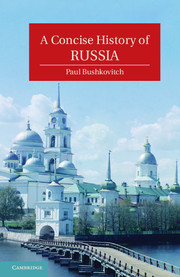Book contents
- Frontmatter
- Contents
- List of Figures
- Abbreviations
- Acknowledgments
- Prologue
- 1 Russia before Russia
- 2 Moscow, Novgorod, Lithuania, and the Mongols
- 3 The Emergence of Russia
- 4 Consolidation and Revolt
- 5 Peter the Great
- 6 Two Empresses
- 7 Catherine the Great
- 8 Russia in the Age of Revolution
- 9 The Pinnacle of Autocracy
- 10 Culture and Autocracy
- 11 The Era of the Great Reforms
- 12 From Serfdom to Nascent Capitalism
- 13 The Golden Age of Russian Culture
- 14 Russia as an Empire
- 15 Autocracy in Decline
- 16 War and Revolution
- 17 Compromise and Preparation
- 18 Revolutions in Russian Culture
- 19 Building Utopia
- 20 War
- 21 Growth, Consolidation, and Stagnation
- 22 Soviet Culture
- 23 The Cold War
- Epilogue
- Further Reading
- Index
21 - Growth, Consolidation, and Stagnation
Published online by Cambridge University Press: 05 June 2012
- Frontmatter
- Contents
- List of Figures
- Abbreviations
- Acknowledgments
- Prologue
- 1 Russia before Russia
- 2 Moscow, Novgorod, Lithuania, and the Mongols
- 3 The Emergence of Russia
- 4 Consolidation and Revolt
- 5 Peter the Great
- 6 Two Empresses
- 7 Catherine the Great
- 8 Russia in the Age of Revolution
- 9 The Pinnacle of Autocracy
- 10 Culture and Autocracy
- 11 The Era of the Great Reforms
- 12 From Serfdom to Nascent Capitalism
- 13 The Golden Age of Russian Culture
- 14 Russia as an Empire
- 15 Autocracy in Decline
- 16 War and Revolution
- 17 Compromise and Preparation
- 18 Revolutions in Russian Culture
- 19 Building Utopia
- 20 War
- 21 Growth, Consolidation, and Stagnation
- 22 Soviet Culture
- 23 The Cold War
- Epilogue
- Further Reading
- Index
Summary
The Soviet Union emerged from the war victorious but with tremendous population losses and economic damage. The number of dead was at least twenty million, twenty-seven million by some estimates, including three million prisoners of war, some seven million soldiers killed in battle, two million Soviet Jews, and at least fifteen million Russian, Ukrainian, and Belorussian civilians. All areas occupied by the Germans were devastated, including the USSR's richest agricultural land and the whole Ukrainian industrial complex, which had supplied the country with almost half of its products on the eve of the war. Housing stock and city services were smashed, and even in unoccupied areas the strain of the war showed everywhere. To make things worse, a bad harvest in 1946 led to famine conditions in much of the country. Soviet reparations from Germany and Eastern European countries helped somewhat, but the scale of loss and destruction was so great that even such measures provided only small recompense for the losses.
At the same time, the victory brought with it a new order in the Kremlin. Soon after the war, Stalin ordered the People's Commissariats to be called Ministries, for he announced (in private) that such names had been appropriate to a revolutionary state, but that the Soviet Union had now consolidated itself enough to operate with more permanent institutions. For the first time Stalin and his inner circle began to delegate power to a series of state committees, usually headed by the principal ministers who managed the main areas of the economy. In principle, Stalin was no longer going to monitor all the details of government and economic activity, and some new faces joined the pre-war leadership. Beria and Zhdanov (until his death in 1948) continued on in Stalin's inner circle, while Molotov, Mikoyan, Kaganovich, and Voroshilov remained from the pre-war years but were less powerful, especially Voroshilov, disgraced by his military failures. New faces in the top leadership were Malenkov (vice-chairman of the Council of Minsters under Stalin's chairmanship), Nikolai Bulganin (minister of defense and a longtime economic manager), and Khrushchev, until 1949 head of the Ukrainian party organization and then of the Moscow city party. To a large extent the system did work in a more regular fashion for the last eight years of Stalin's life, but at the same time he did not refrain from scolding and bullying his closest collaborators and from directing a series of political “cases” with murderous results. The cult of Stalin reached its apogee in the post-war years. Besides the ubiquitous portraits and statues an official adulatory biography appeared on his seventieth birthday. The press produced endless accolades to the “great leader of peoples,” the great Marxist, and the genius military commander Stalin. As much as he may have realized that the USSR needed a more normal mode of government, Stalin could not let go of the reins of power, and continued to behave like a revolutionary commissar of the civil war era, jumping into the middle of the fray with a firing squad ready.
- Type
- Chapter
- Information
- A Concise History of Russia , pp. 393 - 412Publisher: Cambridge University PressPrint publication year: 2011



